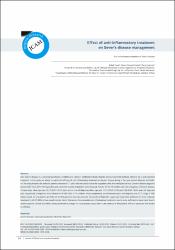| dc.contributor.author | Sayar, Şafak | |
| dc.contributor.author | Ceylan, Hasan Hüseyin | |
| dc.contributor.author | Çaypınar, Barış | |
| dc.date.accessioned | 10.07.201910:49:13 | |
| dc.date.accessioned | 2019-07-10T19:49:55Z | |
| dc.date.available | 10.07.201910:49:13 | |
| dc.date.available | 2019-07-10T19:49:55Z | |
| dc.date.issued | 2019 | en_US |
| dc.identifier.citation | Sayar, Ş., Ceylan, H. H. ve Çaypınar, B. (2019). Effect of anti-inflammatory treatment on Sever's disease management. Journal of Clinical and Analytical Medicine, 10(1), 54-57. https://dx.doi.org/10.4328/JCAM.5839 | en_US |
| dc.identifier.issn | 1309-0720 | |
| dc.identifier.issn | 1309-2014 | |
| dc.identifier.uri | https://dx.doi.org/10.4328/JCAM.5839 | |
| dc.identifier.uri | https://hdl.handle.net/20.500.12511/1817 | |
| dc.description | WOS: 000451875800012 | en_US |
| dc.description.abstract | Aim: Sever's disease is a calcaneal apophysitis condition and common childhood problem. Despite various treatment methods, there is not a gold standard treatment. In this study, we aimed to report the efficacy of anti-inflammatory treatment on Sever's disease during a four-year period. Material and Method: The study includes the pediatric patients, between 6-17 years old, who presented to the outpatient clinic with heel pain and had a Sever's disease diagnosis between 2014 and 2017. Demographics and treatment records of patients were reviewed. Results: Of the 74 children who had a diagnosis of Sever's disease, 59 were boys. Mean age was 10.77 (6.87-15.73) years at the time of diagnosis. Mean age was 11.14 (8.04-15.73) and 9.28 (6.87-13.20) years for boys and girls, respectively. Complaints were bilateral in 46 (62.16%) of 74 children. Mean symptomatic period between pain and diagnosis was 12.7 (range 2-108) weeks. Except for one patient. all of the 69 (93.2%) patients' pain was resolved. Two weeks of ibuprofen usage was found to be sufficient for Sever's disease treatment in 68 (91.89%) of our overall patient cohort. Discussion: Non-steroidal anti-inflammatory medication seems to be sufficient to treat most Sever's disease patients. Simple anti-inflammatory treatment is enough for most primary cases: there is no evidence of the positive effect of expensive heel insoles or orthoses. | en_US |
| dc.language.iso | eng | en_US |
| dc.publisher | Derman Medical Publishing | en_US |
| dc.rights | info:eu-repo/semantics/openAccess | en_US |
| dc.subject | Sever's Disease | en_US |
| dc.subject | Calcaneal Apophysitis | en_US |
| dc.subject | Heel Pain | en_US |
| dc.subject | Ibuprofen | en_US |
| dc.title | Effect of anti-inflammatory treatment on Sever's disease management | en_US |
| dc.type | article | en_US |
| dc.relation.ispartof | Journal of Clinical and Analytical Medicine | en_US |
| dc.department | İstanbul Medipol Üniversitesi, Tıp Fakültesi, Cerrahi Tıp Bilimleri Bölümü, Ortopedi ve Travmatoloji Ana Bilim Dalı | en_US |
| dc.authorid | 0000-0003-1293-4436 | en_US |
| dc.identifier.volume | 10 | en_US |
| dc.identifier.issue | 1 | en_US |
| dc.identifier.startpage | 54 | en_US |
| dc.identifier.endpage | 57 | en_US |
| dc.relation.publicationcategory | Makale - Uluslararası Hakemli Dergi - Kurum Öğretim Elemanı | en_US |
| dc.identifier.doi | 10.4328/JCAM.5839 | en_US |


















